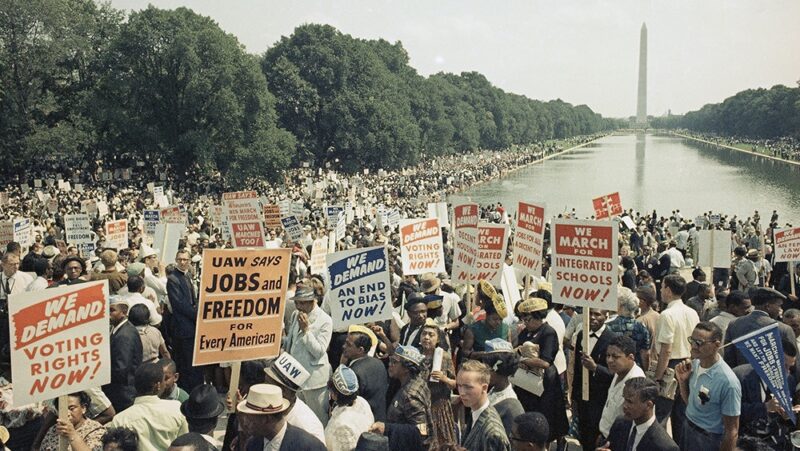Here to top your
best dad joke.

How Lesser-Known Religions Have Protected Religious Freedom for All
The First Amendment prohibits the government from favoring any religious tradition, including nonreligion, over any other. And it protects the right to practice and express beliefs. The right to religious freedom is a guarantee that all Americans can shape their lives according to their deepest beliefs, and that people of all faiths and none are welcome in the public square.
Throughout United States history, as a diverse population has sought to coexist in a religiously free nation, members of less predominant traditions haven’t always been afforded these rights easily. Many members of lesser-known religions have had to push, from the earliest days of the United States’ existence as a nation, for their beliefs to be recognized and protected. In doing so, these First Amendment advocates have helped protect these fundamental freedoms for us all. Watch the videos above for some stories of people from lesser-known religions working to protect religious freedom and read on to learn more about these traditions.
Discover 6 lesser-known religions and how they help protect religious freedom
Conscientious objectors
A person doesn’t have to believe in a god to help protect religious freedom for people of all religions.
According to the Pew Research Center, a growing number of Americans are not affiliated with any religious tradition – 22.8% in 2014 and 29% in 2021. These religious “nones” include atheists who don’t believe in any gods; agnostics who neither believe nor don’t believe in a god; and people who may be spiritual in some way but are not part of any specific religious tradition.
RELATED: Prayer in school: What is (and isn't) protected?
Can deeply held beliefs that don’t include religious belief be protected under the First Amendment?
For Elliot Welsh, the military’s answer was no. Welsh was an atheist and a pacifist who was morally opposed to war. When he was drafted during the Vietnam War, he applied to be a conscientious objector. This designation had been available to religious groups like Quakers and Jehovah’s Witnesses, whose traditions oppose war. Members could receive alternate draft assignments that didn’t include combat. After Welsh’s application was denied, he sued. In 1970, the Supreme Court said that Welsh’s convictions should not be distinguished from religious beliefs just because his beliefs didn’t include religious faith.
This ruling helped set precedent for courts to apply First Amendment protections to deeply held moral positions that involve no faith just as they protect beliefs based on religious traditions.
Jehovah’s Witnesses
The Jehovah’s Witnesses were founded in Pittsburg, Pa., in the 1870s as a subset of Christianity. Witnesses’ beliefs are distinct from Catholic and Protestant teachings in that they do not believe in the Trinity, or the concept of the Father, the Son and the Holy Spirit. Witnesses instead believe that Jesus is the savior and Son of God but is not God. Witnesses believe that human governments will be replaced by the kingdom of Christ on earth and that a small number of faithful people will enjoy resurrection and life in heaven. Due to these beliefs, they avoid involvement in government and public policy, such as declining to serve in the military or salute the flag.
This, along with their door-to-door and public preaching, has been a source of confusion, fear and persecution of adherents.
According to the Witnesses, there are more than 8.5 million believers around the world and more than 1 million in the U.S., making up less than 1% of the U.S. population. Yet this lesser-known religion has had an outsized influence on protecting freedom of religion for all Americans.
Since the early 1900s, members of the Jehovah’s Witnesses faced legal obstacles to living their beliefs. Families like the Gobitases in 1935 and the Barnettes several years later challenged public school requirements that students be compelled to salute the flag. While the Supreme Court ruled against the Gobitases, it changed course in 1943 and supported the Barnettes’ right to decline to participate in speech contrary to their beliefs. Similarly, in 1940, the court overturned a Connecticut law that limited Witnesses’ public preaching, citing the First Amendment and, for the first time, saying that state laws were also bound to protect religious freedom.
Regla de Ocha (Santería)
This tradition originated in the Yoruba region of West Africa in what is now Nigeria and Benin. When enslaved Yoruba people were brought to the Caribbean, particularly Cuba, they brought their traditions. These traditions were not written down, such as in a sacred text. Rather, they were passed along by word-of-mouth among believers who would repeat them aloud to each other.
This practice has sometimes been referred to as Santería, or "way of the saints,” which references how West African deities were identified with Catholic saints to enable traditional beliefs to continue even as the enslaved people were forced to convert to Christianity. Practitioners believe in a supreme being with multiple aspects or manifestations and in orishas, which, like Christian saints, are spiritual intermediaries. Many adherents prefer the terms Regla de Lukumí or La Regla de Ocha-Ifá, which means ruler of the orishas, or spirits.
An estimated 250,000 to 1 million practitioners today in the U.S. consider themselves the children of the orishas, which exist in nature and in the body. Priests and priestesses initiate adherents into communities of believers. Ceremonial practices include rituals of healing and fasting. Rituals to mark milestones sometimes include animal sacrifice. Misunderstandings about this practice have led to the demonization of practitioners by labeling them “un-American” and to the creation of laws against the ritual.
For example, in 1987, Hialeah, Fla., a town with a growing Regla de Ocha community, passed a law to criminalize killing animals, nominally to combat animal cruelty. But the law had several exceptions for hunting, fishing, pest control and kosher slaughterhouses, among others. One exception was notably absent: the Church of the Lukumí’s sacrificial practices. When the church raised objections to the law to the city council, members faced derogatory comments. But the Supreme Court unanimously recognized the law as targeted discrimination against the Regla de Ocha community. In 1993, the court struck down the law, upholding the First Amendment right for members of this lesser-known religion to worship according to one’s own traditions.
The Satanic Temple
Most people might be surprised to learn that members of the Satanic Temple do not worship Satan or even believe in a devil, God or the supernatural at all.
Founders Malcom Jarry and Lucien Greaves started the temple in 2013 based on seven tenets including reason, science, compassion and justice. The Satanic Temple (TST) is not to be confused with the Church of Satan, which was founded by Anton LaVey in the 1960s, also based on humanist values and not Devil worship. The Satanic Temple, though, was founded specifically to counter the dominance of any particular religious tradition in public life and to advocate, as the First Amendment says, that government be neutral toward religion. TST challenges traditional ideas of what a religion is by renouncing “supernaturalism” in their tradition, instead using the symbol of Satan for questioning authority and maintaining personal liberties. As of June 2022, there were more than 700,000 members of the Satanic Temple.
Among TST’s most controversial – but First Amendment-protected – activities are sponsoring After School Satan Clubs at public schools. Unconcerned with converting others, the TST’s clubs focus on fostering curiosity and scientific understanding through puzzle solving, literature lessons and science experiments. In doing so, they hope to provide a “safe and inclusive” religious club for interested students.
Drawing upon their values of church-state separation, members of TST’s 24 chapters generally oppose all religious clubs within public schools. So why create their own club? In 2001, the Supreme Court ruled that if one community-sponsored club is allowed in public schools, then other clubs cannot be excluded simply because their beliefs are unpopular. So, at schools where religious clubs are permitted, especially Christian clubs, the Satanic Temple is likely to make their voice heard in hopes of promoting discussion about the role of religion in government-funded institutions. This view can generate fierce opposition, but by advocating that government be neutral toward religion, the Satanic Temple is advocating for everyone’s First Amendment-protected religious freedom.
Sikhism
Sikhism is the fifth largest religion in the world in terms of the number of practitioners yet makes up less than 1% of the U.S. population, with approximately 500,000 Sikh residents. This lesser-known religion was founded by Guru Nanak in the 1500s in Punjab in what is now India. Sikh means disciple and among Sikhism’s core tenets are gratitude, a focus on service to others, and a belief that God is equally present in all people of all faiths.
Sikhs also believe in a cycle of reincarnation, and Sikhism’s sacred text, compiled by its founding gurus, is the centerpiece of the place of worship.
Many Sikhs wear turbans as a symbol of their beliefs, and those who have been formally initiated also embrace five articles of the faith: “kesh” (uncut hair), “kanga” (a small comb), “kara” (a steel bracelet), “kirpan” (a ceremonial knife) and “kachera” (undergarments).
These articles of faith have led to Sikhs facing discrimination for their appearance and practices. For example, in the 1990s, three Sikh siblings were suspended from their California school for carrying their kirpans after policies against weapons on school grounds were tightened. The Cheema family demonstrated that other districts accommodated ceremonial kirpans by rendering the blades unusable.
Similarly, when Simratpal “Simmer” Singh joined the U.S. Army, policies against long hair and beards meant he had to choose between military service and his deepest beliefs. Singh chose his country, cutting his hair and beard despite his faith. Some 10 years later, when the Religious Freedom Restoration Act raised the bar for when government may limit religious exercise, Singh challenged the army’s policies, and the regulations were changed in 2017 to make religious accommodations.
Wicca
Wicca is a modern religion rooted in pre-Christian spiritual traditions. It is sometimes referred to as a pagan faith; this term originated in ancient Rome to refer to any non-Christians and is now used to refer to a variety of traditions that often centers around a reverence for nature. Many Wiccans believe in a god and goddess while others believe in more deities or none but rather revere nature as sacred.
While some Wiccans form communities or formal structures, such as the Church of Wicca, founded in 1958, by and large it is an independent practice. This makes it hard to know how many people are practicing Wiccans. According to a 2014 estimate by the Pew Research Center, 0.3% of Americans, around 100,000 people, identified as Wiccan or Pagan.
Wicca does not have a single sacred text or a specific code of beliefs and can include a broad range of beliefs. One core focus is on rituals that include magic or drawing from spiritual or universal energy. Some Wiccans call celebrations that occur at the start and peak of seasons Sabbats. These center on how the changing seasons impact nature and how these changes may be mirrored in people, such as spring being a time of fertility. Magic is considered a practice of self-growth and for use to do good, not harm, but Wiccans’ association with magic, and, erroneously, the occult, has been one source of confusion and mistrust.
U.S. courts have also grappled with defining Wicca as a religion at all because it is so dissimilar to more widely practiced belief systems such as Christianity, Judaism and Islam, all of which have codes of belief, holy books and formal hierarchies. Historically, government agencies and courts in the U.S. have been most likely to protect religious freedom for traditions that most closely resemble the organized structures of more predominant religions.
For example, when Herbert Dettmer, a member of the Church of Wicca, was in prison in Virginia, he asked for some items he needed for his religious practice, including candles, sea salt and a white robe. The Virginia prison system denied him access to these items, even though people of other faiths in the prison were able to access similar things. At the time, the government did not consider Wicca a legitimate religious practice protected by the First Amendment, so Dettmer’s request was quickly dismissed. Dettmer challenged the prison system in court and, in 1985, the District Court ruled that the Church of Wicca is a recognized religion protected under the First Amendment. Although Dettmer’s religious exemption was retracted a year later by the Circuit Court, the case is still considered a religious freedom victory for the Wicca tradition and paved the way for more successful free exercise suits, such as the right to wear religious dress in public schools or have Wiccan symbols on gravestones.
Religious freedom means the right to believe and to live by one's tradition. The First Amendment forbids the government from telling us what to think or believe or from treating people differently due to their religious identity, or lack thereof. This right protects all Americans – including followers of lesser-known religions and the growing number of religiously unaffiliated – as we each decide what values, principles and beliefs shape our lives.
Related Content


